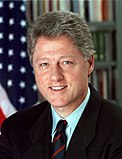1996 United States presidential election
| |||||||||||||||||||||||||||||||||||||
538 members of the Electoral College 270 electoral votes needed to win | |||||||||||||||||||||||||||||||||||||
|---|---|---|---|---|---|---|---|---|---|---|---|---|---|---|---|---|---|---|---|---|---|---|---|---|---|---|---|---|---|---|---|---|---|---|---|---|---|
| Turnout | 49.0%[1] | ||||||||||||||||||||||||||||||||||||
| |||||||||||||||||||||||||||||||||||||
 Presidential election results map. Blue denotes states won by Clinton/Gore and red denotes those won by Dole/Kemp. Numbers indicate electoral votes cast by each state and the District of Columbia. | |||||||||||||||||||||||||||||||||||||
| |||||||||||||||||||||||||||||||||||||
The 1996 United States presidential election happened on November 5, 1996. Bill Clinton, the incumbent president and Democratic candidate, won reelection. He defeated Bob Dole, the Republican candidate, who was the former Senator of Kansas for president, and Ross Perot, the Reform Party candidate, who was a businessman.
Perot received less media attention and was not included in the presidential debates and, while still getting large results for a third-party candidate, by U.S. standards, did not renew his success in the 1992 election.
Clinton benefited from an economy that recovered from the early 1990s recession, and a relatively stable world stage. On November 5, 1996,[2] President Clinton went on to win re-election by a substantial popular vote margin with a large electoral college victory.
Election statistics
[change | change source]President Clinton went on to win re-election relatively easily despite becoming the first sitting president since Woodrow Wilson in 1916 to do so with under 50% of the National Vote (49%), while winning enough states to earn him 379 electoral votes. Senator Bob Dole from Kansas ran for the Republicans and was at the mercy of peaceful overseas relations and a thriving economy. He gained (41%) of the vote while winning enough states to win 159 electoral votes. The GOP did well in the congressional races however thus effectively positioning themselves for the 1998 midterms and the subsequent 2000 race for the White House.
References
[change | change source]- ↑ "Dave Leip's Atlas of U.S. Presidential Elections". uselectionatlas.org. Retrieved October 21, 2012.
- ↑ "Election Dates". uselectionatlas.org. Retrieved 2020-08-06.
Other websites
[change | change source]![]() Media related to United States presidential election, 1996 at Wikimedia Commons
Media related to United States presidential election, 1996 at Wikimedia Commons



